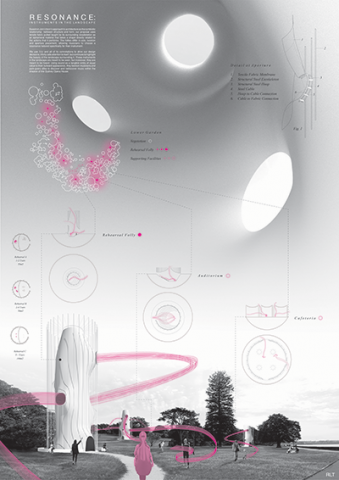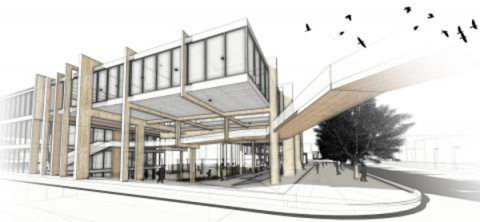How do you design a park located near one of the world’s iconic structures in a city you’ve never been to and win international praise?
Ask four recent University of Louisiana at Lafayette graduates.
They are among a half dozen current and former students in the School of Architecture and Design whose work has earned global applause recently.
An architecture contest sponsored by ARCHmedium asked competitors to create an entertainment pavilion in the botanical gardens that border the famed Sydney Opera House in Australia. The goal of the Sydney Rehearsal Follies, the competition’s official name, was a subtle proposal that complemented the structure Danish architect Jorn Utzon designed in 1955.
Recent graduate Jessica Landry, a native of Bayou Goula, La., was a finalist. Her project, “Acoustic Fluidity,” asked an intriguing question: What does sound look like?
She investigated octaves, volume and different genres of music before creating a series of colorful, twisting metallic structures that would reflect off the waters of Sydney Harbor. For a boat passenger looking toward the botanical gardens, the design would “appear as a sound bar that led you to the Sydney Opera House,” said Landry, who plans to pursue a master’s degree in architecture at UL Lafayette.
Page Comeaux, Katie Murphy and Francisco Farrera’s “Resonance” won an honorable mention in the same competition. The team began its design by first studying how Utzon conceptualized the opera house project six decades ago.
Like Landry, none of the team’s members had visited Sydney.
“Developing a project on the opposite side of the world made us feel somewhat disadvantaged, especially compared to competitors who are native Australians,” Comeaux said. “However, architecture and space are universal concepts, regardless of where the project is located. Since we were designing near the Sydney Opera House, a site with visitors from around the world, we designed based on what we would like to experience if we were tourists in Sydney.”
Comeaux, a native of New Iberia, La., graduated earlier this month from UL Lafayette and will pursue a master’s degree at Yale University’s School of Architecture. Farrera, a native of Guatemala, and Murphy, from Kaplan, La., plan to pursue graduate degrees in architecture at UL Lafayette following commencement.
The ARCHmedium competition drew entrants from five continents. UL Lafayette students submitted eight designs, and judges honored two. A gallery of all the submissions is at http://student.archmedium.com/competition/srf/results/.
“We are going up against people from all over the world, top schools as well as individuals,” said Corey L. Saft, a professor of architecture who, along with assistant professor Ashlie Latiolais, oversaw the design competition class where the projects originated. “The competition system is a meritocracy that works well. Nothing else but the quality of the work is being addressed.
“It’s just great for our school and our students to get the recognition they deserve. We produce competitive, high-quality students who produce high-quality work,” he added.
Two recent architecture graduates also earned international attention for work they completed last year in Saft’s design competition class.
Holdton B. Jones and Taylor Ward countered the claustrophobia of urban life in New York by restoring pedestrian-friendly spaces in the city’s Lower East Side. Their proposal, Roots in the City, is included in Archiprix International Ahmedabad 2017, an exhibition of the best student-produced projects organized in cooperation with CEPT University in Ahmedabad, India.
Faculty in the School of Architecture and Design nominated Jones and Ward’s project, which joined 385 other entrants from 87 countries in the exhibition. Each is featured at http://www.archiprix.org/2017/?m=22.
The pair traveled to New York and performed site studies, which revealed an “evident disconnect among the neighborhood,” Jones said. Centuries of development had robbed the Lower East Side of communal spaces. Traffic cascading into the area from the Williamsburg Bridge, which connects Manhattan to Brooklyn, imperiled pedestrians.
Jones and Ward learned that lesson firsthand. While cycling across the bridge, they discovered that the elevated bike lane on which they were riding abruptly – and unexpectedly – ended. The pair integrated the experience into their proposal to combine two city blocks into a depressed pedestrian plaza among the area’s residences, museums and markets.
“We went from flying down the bridge to dodging cars and pedestrians on the street,” Jones recalled. “This led us to propose an extension of the elevated bike lane – doubling as a pedestrian bridge – from the Williamsburg Bridge into the plaza within our site, allowing for the traffic to be bypassed and making a direct, safe connection.”
Jones is a native of Lake Charles, La. He’ll complete his master’s degree in architecture at UL Lafayette in December. Ward is from Baton Rouge. He’s currently pursuing his master’s degree in architecture at the Parsons School of Design in New York. Both earned bachelor’s degrees in architecture at UL Lafayette in 2016.

Top image: Jessica Landry's “Acoustic Fluidity"
Inset image: Page Comeaux, Katie Murphy and Francisco Farrera’s “Resonance”
Bottom image: Holdton B. Jones and Taylor Ward's Roots in the City entry
